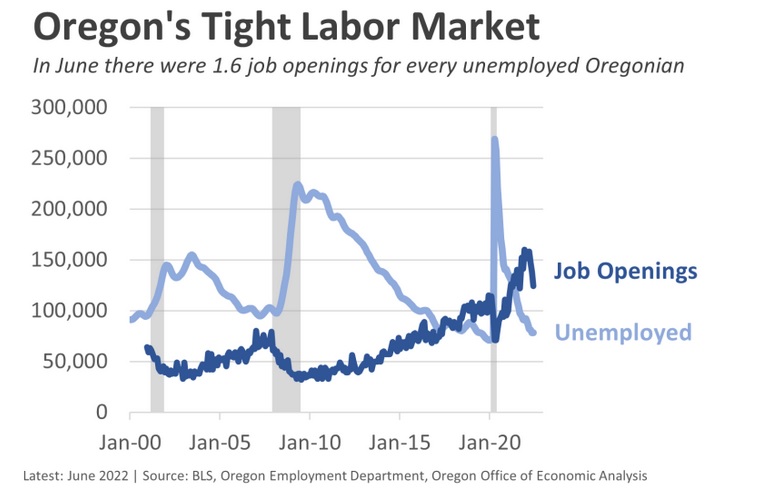
By Josh Lehner,
Oregon Economic Analysis Office,
Normally economists think about job openings as a leading indicator. If businesses are looking to grow and increase production, they will usually put out a job posting prior to actually hiring someone. The issue today is that job openings nationally and here in Oregon are declining in recent months. However, instead of foretelling doom, the recent decline is likely good news. Or it should be.
Right now we know the labor market is “unsustainably hot” as Fed Chair Powell says. The demand for labor, or the amount businesses are looking to hire outstrips the supply of labor, or the number of folks looking for work. Earlier this year there were 1.9 job openings in Oregon for every unemployed Oregonian. This imbalance leads to increased competition for workers and fast-rising wages.
Wage growth is important of course. But what we care about is real, or inflation-adjusted wage growth. Positive real wage growth means our incomes stretch further and our standard of living is increasing. That isn’t the case today where inflation is outpacing the strong wage gains for the vast majority of workers. At a base level, wage growth represents nominal spending power for workers and households. The more we earn, the more we can spend. If productivity growth does not offset these labor costs for firms, prices rise.
Now, there are two ways to get better labor market balance. One would be for the number of unemployed Oregonians to increase considerably to match the number of job openings. Given the economy is at full employment and everyone who wants a job in Oregon essentially has one, it would have to be from a big increase in layoffs. There is not a reserve army of would-be workers sitting on the couch today.
The other path toward better balance is to see a decrease in the number of job openings. This is something the Federal Reserve is explicitly watching and effectively targeting. In a slower growing economy due to higher interest rates, consumer spending and business revenues will increase but at a more measured pace. Firms will slow their hiring plans as a result, lessening the intense competition for workers and taking some of the pressure off the labor market. Plus as firms regain their pre-pandemic staffing levels, they should feel a little less desperate to hire. I think that is what we starting to see in recent months. That 1.9 job openings per unemployed Oregonian back in March is now 1.6 job openings per unemployed Oregonians in June. Still a clear imbalance and very tight labor market. But movement toward better balance is still movement toward better balance and a soft landing.
Another thing that’s striking about this chart is it clearly shows how slack the labor market has been for so much of the 2000s. The double recessions of the dotcom and housing busts meant the economy, on average, was weak at best. Today’s tight labor market is a far cry from those days. Just another way that this cycle is different.
Note that our office will flesh out this discussion a bit further in our upcoming forecast document in terms of layoffs, the probability of workers finding a job, wage growth and the like. Our next forecast will be released at the end of the month on Wednesday, August 31st.
Disclaimer: Articles featured on Oregon Report are the creation, responsibility and opinion of the authoring individual or organization which is featured at the top of every article.

